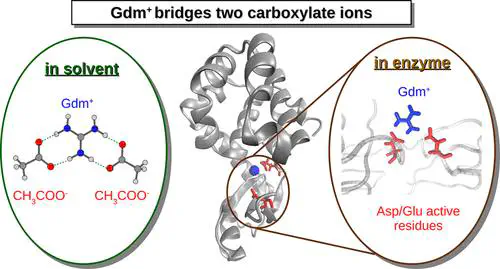Role of Guanidinium-Carboxylate Ion Interaction in Enzyme Inhibition with Implications for Drug Design
 Image credit: G. Reddy
Image credit: G. Reddy
Abstract
Guanidinium cation (Gdm+) interacts strongly with amino acids of different polarities modulating protein structure and function. Using density functional theory calculations and molecular dynamics simulations, we studied the interaction of Gdm+ with carboxylate ions mimicking its interaction with acidic amino acids and explored its effect in enzymatic folding and activity. We show that, in low concentrations, Gdm+ stabilizes carboxylate ion dimers by acting as a bridge between them, thereby reducing the electrostatic repulsion. We further show that this carboxylate–Gdm+–carboxylate interaction can have an effect on the structure–activity relationship in enzymes with active sites containing two acidic residues. Using five enzymes (hen egg white lysozyme, T4 lysozyme, HIV-1 protease, pepsin, and creatine kinase), which have two acidic amino acids in their active sites, we show that, in low concentrations (<0.5 M), Gdm+ strongly binds to the enzyme active site, thereby potentially inhibiting its activity without unfolding it. This can lead to misleading conclusions in experiments, which infer the extent of enzyme unfolding from activity measurements. However, the carboxylate–Gdm+–carboxylate specific interaction can be exploited in drug discovery as drugs based on guanidinium derivatives are already being used to treat various maladies related to muscle weakness, cancer, diabetes etc. Guanidinium derivatives can be designed as potential drug molecules to inhibit activity or functioning of enzymes, which have binding pockets with two acidic residues in close vicinity.